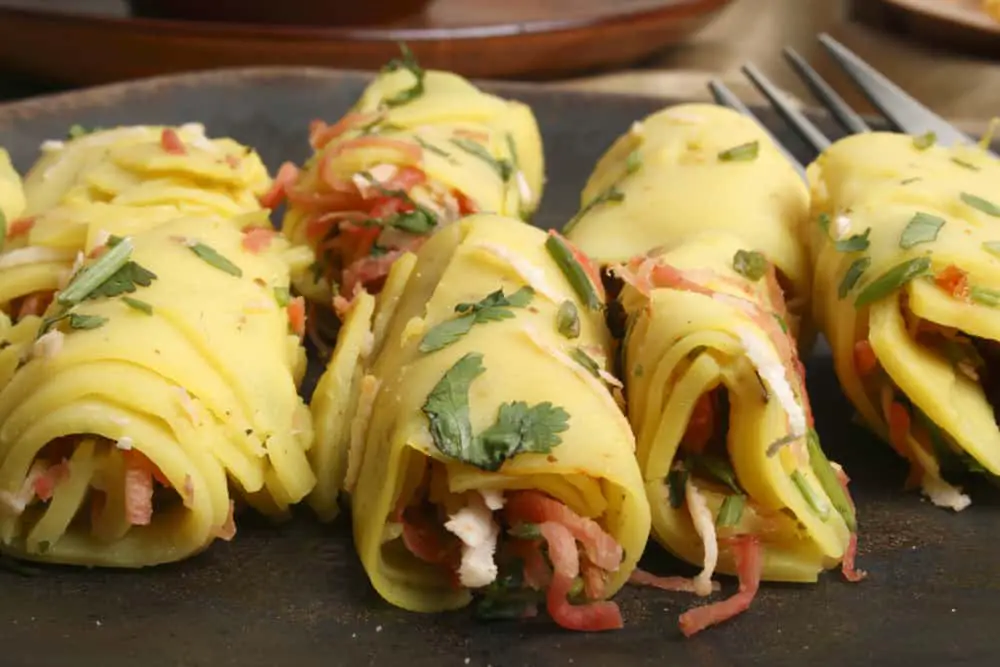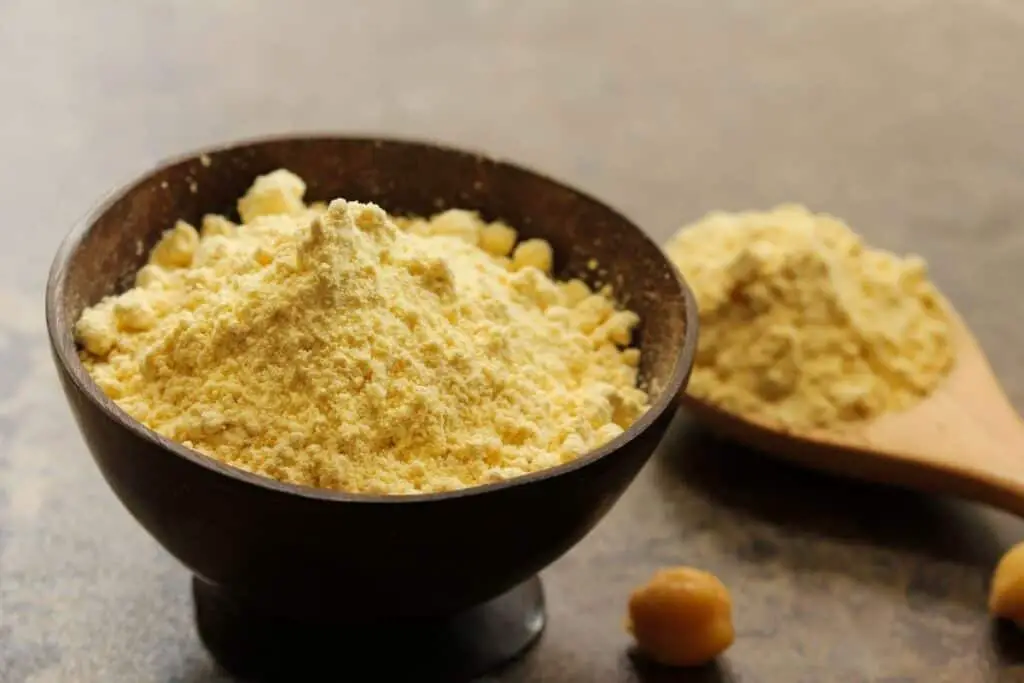It seems as though these days there is a huge variety of flour alternatives available to suit all different types of dietary requirements. From buckwheat to almond, coconut to rice flour, the list is endless. One flour that is proving particularly popular is gram flour.

If you’re new to the world of flour alternatives, you may be wondering what gram flour is made from and how you can use it in your cooking. In this article, we’ll provide you with all the incredible details of this flour, and how you can make it at home.
If you’re ready to learn about the wonders of gram, read on to discover more.
What is Gram Flour Made Of?
Gram flour, or chickpea flour as it’s otherwise known, is a finely ground ingredient made from cooked and roasted chickpeas. Naturally gluten-free, this flour is pale yellow with a silky texture.
This flour is packed with health benefits and provides minerals and nutrients that are vital for the human body to grow and function properly.
Gram flour is commonly used as the main ingredient in Indian cuisine, as well as across some Asian, Middle Eastern, and also European dishes.
Due to its popularity, this flour can easily be found in most convenience stores across the globe, however, it is also easily made at home.
How is It Made?
Making gram flour is a fairly straightforward process. To make it you will need either a food processor, a high-speed blender, or a grain mill.
You can also roast your chickpeas before use, but ensure that they are completely cool before turning them into flour.
Grain Mill Method
- To begin, wash your chickpeas to get rid of any nasty pesticides that may be on them and dry them thoroughly.
- Make sure that the setting is on fine flour before you start.
- Place the chickpeas in the mill, turn it on, and watch your chickpeas magically turn into fine flour.
Food Processor/High-Speed Blender Method
- Wash your chickpeas and dry them thoroughly before use.
- Add them to your blender using the dry grains jar.
- Blitz the chickpeas for 2-3 minutes until they turn to powder.
- If you are trying to make a large amount of flour it is easier to do this in smaller batches when using the high-speed blender.
If you find that there are some large lumps in your flour, simply sift it through a fine-mesh sieve which will separate the flour from any chickpeas that remain.
You can then return these chickpeas to your blender or mill and process them again for more flour.
Other Names for Gram Flour
As well as the name ‘gram flour’, there are many other alternatives that it may be called. You may hear it being referred to as chickpea flour, besan flour, or even garbanzo bean flour.
Although they are very similar and use chickpeas as their main ingredient, there are some differences between these flours, such as the type of chickpeas that are used and which recipes they can be used in.
What Does Gram Flour Taste Like?

Many users of this flour describe the taste as nutty with an earthy smell, and it is perfect for both savory and sweet recipes.
Raw gram flour is often described as having a slightly bitter taste to it while the roasted variety is less bitter with a stronger flavor.
Is Gram Flour the Same as Chickpea Flour?
Gram flour and chickpea flour are both derived from chickpeas, however, there is a difference between the two. Gram is typically made from split brown chickpeas, whereas chickpea flour is made from using white chickpeas.
Is Gram Flour the Same as Plain Flour?
You may be fooled into thinking that gram and plain flour are the same, but they’re actually very different.
Plain flour is wheat flour which is typically stripped of most of its nutrients, bleached, and then packed with nutrients to replace what was initially removed.
Gram flour is made from blending chickpeas and compared to most other flours, it is very high in protein content.
Black Gram Flour
Black gram flour is made from ground black gram lentils or urad dal and has a fine powder-like consistency. Once blended into flour, it is typically golden brown.
Bengal Gram Flour
Bengal gram is another name for the Indian black chickpea. Much like other chickpeas, the Bengal gram is packed with nutrients and is rich in protein, vitamins, and fiber. It is small and ranges from light to dark brown.
Green Gram Flour
Green gram flour is created using green garbanzo beans. They are a fantastic source of folic and iron and provide the same nutty flavor of other gram flours but with a slightly sweeter taste to them.
What is a Substitute for Gram Flour?
If you are on the hunt for a substitute, there are plenty of options out there. To achieve a similar flavor and composition, we’d recommend trying lentil flour, fava bean flour, dal flour, or soybean flour.
All of these flours can be made at home using the same method as you would for gram flour. You can also try buckwheat flour which will provide you with that same nutty taste as gram has.
Nutrition
Is Gram Flour Healthy?
Gram flour is packed with healthy nutrients and is a great alternative to refined wheat flour. It is lower in both carbs and calories than wheat flour and richer in both protein and fiber.
Research into this flour has also shown that it could possess antioxidant potential. If so, this could help decrease levels of the compound acrylamide that is often found in processed foods and is considered harmful.
One cup provides the following nutritional amounts:
- Calories – 356
- Fat – 6g
- Sodium – 59 mg
- Fiber – 10g
- Carbohydrates – 53g
- Protein – 21g
- Sugars -10g
Carbs
Total calories in one cup of chickpea flour are roughly 350. Carbohydrates account for the majority of these calories, with 10 grams coming from both fiber and sugar, and the rest from starch.
Protein
Chickpea flour has more than 20 grams of protein per cup. If you want to improve your protein consumption, this flour is a simple way to do it.
Vitamins and Minerals
This flour is made from chickpeas which are packed full of vitamins and minerals such as iron, magnesium, zinc, and folate. It’s also a great source of thiamine, phosphorus, and copper, as well as manganese.
Health Benefits
Because gram flour has significantly more protein, fiber, and vitamins than wheat flour, it is an excellent method to boost the nutritional value of your meals.
It also contains minerals that are necessary for strong bones, teeth, a healthy immune system, and normal muscle and nerve function.
There are also plenty of other health benefits to using this flour such as:
- Promotes heart health
- Can control blood sugar levels
- Supports healthy bacteria
- Helps prevent neural tube defects
- Aids satiety
- Supports a gluten-free diet
Uses for Gram Flour

This flour is a great ingredient to keep in your kitchen as there are so many ways in which you can use this flour. Here are the best ways to make the most of your flour.
Use as a Thickener
If your recipe calls for cream, cornflour, or wheat flour, simply replace them with gram flour which will act as a thickener.
It is especially good to use in soups, sauces, or curries and helps prevent any curdling in warm yogurt-based sauces.
Use as a Gluten-Free Baking Flour
When it comes to cakes, biscuits, and bread, gram flour can be used to make these into gluten-free foods.
If you need a lighter crumb for your baking, try combining gram with another gluten-free flour, such as rice or potato flour, which will give your baking a deliciously light finish.
Use as an Egg Replacer
Gram flour is incredibly absorbent which makes it perfect as a substitute for eggs in any vegan cooking or those with allergies.
This flour can be mixed with water in equal parts and used just like chia seeds or flaxseeds to replace eggs.
Use as a Batter or Crumb Coating
Mixing gram flour with seasoning and either beer or sparkling water is a great way of making a thin, crispy tempura-style batter.
It is also a great ingredient for using as a crumb on your favorite meat. Just add your favorite seasoning and prepare your meat with your gram flour coating.
What Else is It Good for?
As well as being used for cooking purposes, this flour also holds some beauty secrets.
Does Gram Flour Remove Facial Hair?
Thanks to its exfoliating properties, this flour, combined with rose water, is the perfect remedy for removing and preventing facial hair.
To use, mix 2 tablespoons of flour with 2 tablespoons of rose water. Mix the ingredients to form a paste and apply it to your face.
When the paste has dried completely, rub it off using your fingers and watch your facial hair disappear.
Use this hair removal remedy twice a week for quick results, but make sure you are gentle while rubbing off your mask as it can cause redness.
Does Gram Flour Whiten Skin?
This flour is also a great way to lighten any dark areas of skin you may have. Our favorite recipe is tomato, gram flour, and lemon as these ingredients, when used together, have incredible bleaching properties.
Mix tomato pulp with the flour and the juice of half a lemon. When you have a paste, apply this to your skin and leave it on for around 20 minutes. Wash off after twenty minutes and repeat this 3 times a week.
Not only will this mixture leave your skin feeling soft and silky, but it will also help your skin to glow and with continual use, lighten.
Final Thoughts
As this article shows, this flour is a versatile ingredient that can be used in many ways. Whether you’re looking to bake, cook, or even if you need alternative beauty remedies, gram is your answer.
What’s even better is that it’s super easy to make at home, so you can always keep a jar close by.
Try it in your favorite recipes today, and we guarantee that you’ll ask yourself what took you so long to discover and try this delicious gluten-free flour alternative.
